Quick Summary:
- Make your homepage visually captivating with clear calls to action.
- Showcase high-quality music, concert dates, and sell merchandise.
- Share your band’s story and ensure easy contact for fans.
- Utilize backend tools for security and website management.
Table of Contents
- 1. A Captivating Home Page: Your Digital Stage
- 1.1. High-Quality Visuals: Show, Don’t Just Tell
- 1.2. Headline and Tagline: Your Band’s Elevator Pitch
- 1.3. Call to Action (CTA): Guide Your Visitors
- 1.4. Social Media Integration: Extend Your Reach
- 2. Music Player: Let Your Music Speak
- 2.1. High-Quality Audio Streaming: Deliver a Great Listening Experience
- 2.2. Playlist Functionality: Guide Listeners Through Your Catalog
- 2.3. Purchase Links: Turn Listeners into Buyers
- 2.4. Lyrics Display: Enhance the Experience
- 3. Concert Schedule: Keep Fans in the Loop
- 3.1. Clear and Organized Presentation: Make it Easy to Find Shows
- 3.2. Interactive Map Integration: Help Fans Find the Venue
- 3.3. Ticket Purchase Integration: Streamline the Buying Process
- 3.4. Email Newsletter Sign-up: Keep Fans Informed
- 3.5. Past Show Archive: Showcasing your History
- 4. Band Bio: Tell Your Story
- 4.1. Compelling Narrative: Hook Your Readers
- 4.2. High-Quality Photos: Visual Support
- 4.3. Band Member Profiles: Introduce the Team
- 4.4. Contact Information: Make it Easy to Reach You
- 4.5. Press Kit: For Media and Industry Professionals
- 5. Merchandise Store: Sell Your Brand
- 5.1. Easy-to-Navigate Storefront: A Seamless Shopping Experience
- 5.2. High-Quality Product Images: Showcase Your Merchandise
- 5.3. Secure Payment Processing: Build Trust
- 5.4. Shipping and Handling Information: Set Expectations
- 5.5. Inventory Management: Avoid Disappointments
- 6. Qrolic Technologies: Your Partner in Website Excellence
- 6.1. Custom Website Design: Tailored to Your Band’s Identity
- 6.2. Responsive Design: Reach Fans on Any Device
- 6.3. E-Commerce Solutions: Sell Your Music and Merchandise Online
- 6.4. SEO Optimization: Get Discovered Online
- 6.5. Ongoing Support and Maintenance: Peace of Mind
- 7. Essential Back-End Features
- 7.1. Content Management System (CMS): Take Control
- 7.2. Analytics Tracking: Measure Your Success
- 7.3. Security Features: Protect Your Website
- 7.4. Database Management: Organize Your Data
- 7.5. Email Marketing Integration: Communicate with Your Fans
- 8. Beyond the Basics: Elevating Your Website
- 8.1. Fan Forum: Build a Community
- 8.2. Live Streaming Integration: Connect in Real-Time
- 8.3. Interactive Elements: Engage Your Audience
- 8.4. Multilingual Support: Reach a Global Audience
- 8.5. Accessibility Features: Make Your Website Inclusive
1. A Captivating Home Page: Your Digital Stage
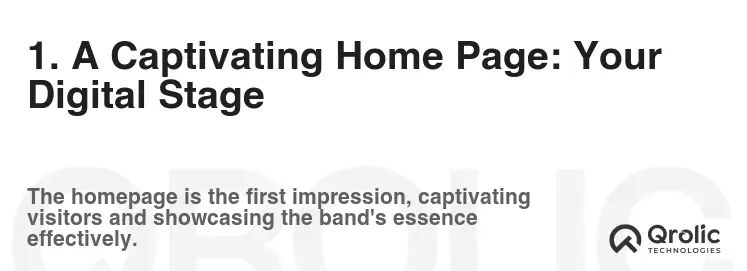
Your band’s website is often the first encounter potential fans have with your music. It’s crucial to make a stellar first impression. Think of your homepage as your digital stage – it needs to grab attention, showcase your brand, and entice visitors to explore further.
1.1. High-Quality Visuals: Show, Don’t Just Tell
- Why it matters: Visuals are processed 60,000 times faster than text. They convey emotion, atmosphere, and personality instantly. Low-quality or outdated visuals can make your band look amateurish.
- What to include:
- Professional Photos: Invest in a professional photoshoot. Capture the essence of your band – are you energetic rockers, soulful blues artists, or introspective indie musicians? Your photos should reflect that. Use a variety of shots: band shots, individual portraits, and action shots from live performances.
- Eye-Catching Graphics: Use graphics that are consistent with your band’s branding. This includes your logo, color scheme, and overall aesthetic.
- Video Integration: Embed a high-quality music video or live performance clip directly on your homepage. Video is incredibly engaging and can quickly hook visitors.
- SEO Optimization:
- Image Alt Text: Use descriptive alt text for all images. This helps search engines understand what the image is about and improves your website’s SEO. For example, instead of “image1.jpg,” use “Band Name Live Performance at The Roxy, Los Angeles.”
- Image Optimization: Optimize images for web use. Large image files can slow down your website’s loading speed, which can negatively impact your SEO. Use tools like TinyPNG or ImageOptim to compress images without sacrificing quality.
1.2. Headline and Tagline: Your Band’s Elevator Pitch
- Why it matters: Your headline and tagline are the first words visitors will see. They need to be concise, memorable, and clearly communicate what your band is about.
- What to include:
- Headline: A bold statement that grabs attention. Example: “Band Name: Bringing the Funk to Your Soul.”
- Tagline: A short, descriptive phrase that elaborates on your headline. Example: “Original Funk-Rock Fusion from the Heart of Chicago.”
- SEO Optimization:
- Keyword Integration: Incorporate relevant keywords into your headline and tagline. For example, if you’re a “country-rock band,” make sure those terms are included.
- Clarity and Relevance: Ensure your headline and tagline accurately reflect your band’s genre and style.
1.3. Call to Action (CTA): Guide Your Visitors
- Why it matters: A clear call to action tells visitors what you want them to do next. Without a CTA, they might simply leave without engaging further.
- What to include:
- “Listen Now”: Directs visitors to your music player or streaming platforms.
- “See Upcoming Shows”: Takes them to your concert schedule.
- “Join Our Mailing List”: Encourages them to subscribe for updates.
- “Buy Our Album”: Leads them to your online store.
- Best Practices:
- Make it Prominent: CTAs should be visually distinct and easy to find.
- Use Action-Oriented Language: Use verbs like “Listen,” “See,” “Join,” and “Buy.”
- Create a Sense of Urgency: Consider using phrases like “Limited Time Offer” or “Get Your Tickets Now.”
1.4. Social Media Integration: Extend Your Reach
- Why it matters: Social media is a powerful tool for promoting your band and connecting with fans. Integrating your social media feeds into your website makes it easy for visitors to follow you on their favorite platforms.
- What to include:
- Social Media Icons: Display icons for all your active social media accounts (Facebook, Instagram, Twitter, YouTube, Spotify, etc.). Make sure these icons are clearly visible and link directly to your profiles.
- Embedded Feeds: Embed your latest posts from your most active social media platforms. This keeps your website fresh and engaging and encourages visitors to follow you.
- Best Practices:
- Choose the Right Platforms: Focus on the platforms where your target audience is most active.
- Maintain Consistent Branding: Ensure your social media profiles are consistent with your website’s branding.
- Engage with Your Followers: Respond to comments and messages promptly and interact with your fans.
2. Music Player: Let Your Music Speak
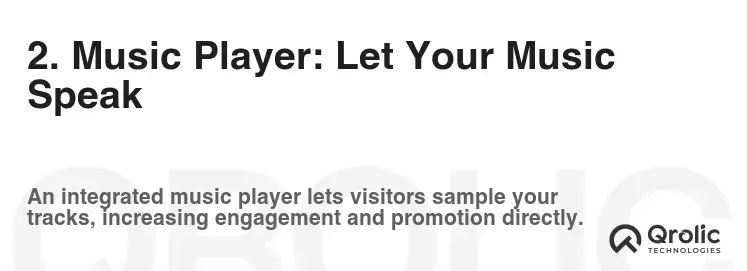
A dedicated music player is an essential feature for any band’s website. It allows visitors to easily listen to your music without leaving your site, and it provides a convenient way for them to discover your discography.
2.1. High-Quality Audio Streaming: Deliver a Great Listening Experience
- Why it matters: The quality of your audio streaming directly impacts the listener’s experience. Low-quality audio can sound distorted or muffled, which can turn off potential fans.
- What to include:
- High Bitrate Audio: Use a high bitrate (at least 192 kbps) for your audio files to ensure clear and crisp sound quality.
- Mobile Optimization: Ensure your music player is optimized for mobile devices. Many fans will be listening to your music on their phones or tablets.
- Technical Considerations:
- File Format: MP3 is a widely supported file format for audio streaming.
- Streaming Server: Consider using a dedicated streaming server for reliable and fast audio delivery.
2.2. Playlist Functionality: Guide Listeners Through Your Catalog
- Why it matters: Playlists make it easy for visitors to discover different aspects of your music. You can create playlists based on album, genre, mood, or theme.
- What to include:
- Album Playlists: Showcase your albums in their entirety.
- “Best Of” Playlists: Highlight your most popular tracks.
- Genre-Specific Playlists: Categorize your music by genre.
- User Experience:
- Easy Navigation: Make it easy for visitors to browse and select playlists.
- Clear Titles and Descriptions: Provide clear titles and descriptions for each playlist.
2.3. Purchase Links: Turn Listeners into Buyers
- Why it matters: Make it easy for visitors to purchase your music after they’ve listened to it. Include direct links to your online store or to popular music retailers like iTunes, Amazon, or Bandcamp.
- What to include:
- “Buy Now” Buttons: Place “Buy Now” buttons next to each track or album in your music player.
- Multiple Retailers: Provide links to multiple retailers to give fans a variety of purchasing options.
- Integration:
- Affiliate Links: Consider using affiliate links to earn a commission on sales.
2.4. Lyrics Display: Enhance the Experience
- Why it matters: Displaying lyrics alongside your music can enhance the listening experience and help fans connect with your songs on a deeper level.
- What to include:
- Synchronized Lyrics: Display lyrics in sync with the music.
- Lyric Search: Allow visitors to search for specific lyrics.
- Technical Considerations:
- Lyric Database: Utilize a lyric database or API to automatically display lyrics.
- Manual Input: If you prefer, you can manually input lyrics for each song.
3. Concert Schedule: Keep Fans in the Loop
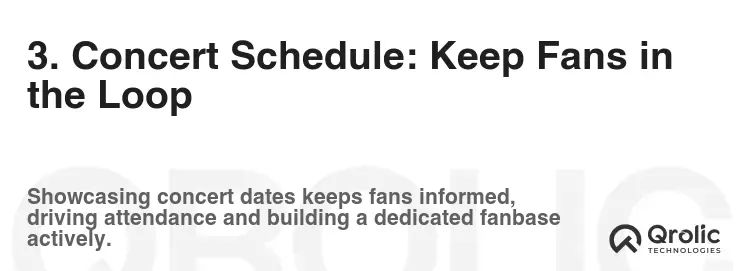
A well-maintained concert schedule is crucial for letting fans know where and when they can see you perform live. It should be easy to find, easy to read, and regularly updated.
3.1. Clear and Organized Presentation: Make it Easy to Find Shows
- Why it matters: A cluttered or confusing concert schedule can frustrate fans and make them less likely to attend your shows.
- What to include:
- Date: Clearly display the date of each concert.
- Venue: Include the name and address of the venue.
- City and State: Specify the city and state where the concert is taking place.
- Time: List the time of the concert.
- Ticket Information: Provide links to purchase tickets.
- Organization:
- Chronological Order: List concerts in chronological order, with the most upcoming shows at the top.
- Visual Hierarchy: Use headings and subheadings to create a clear visual hierarchy.
3.2. Interactive Map Integration: Help Fans Find the Venue
- Why it matters: An interactive map makes it easy for fans to find the venue and plan their route.
- What to include:
- Embedded Map: Embed a Google Map or other mapping service directly into your concert schedule.
- Directions: Provide links to get directions to the venue.
- User Experience:
- Mobile Optimization: Ensure the map is responsive and easy to use on mobile devices.
- Zoom Functionality: Allow visitors to zoom in and out on the map.
3.3. Ticket Purchase Integration: Streamline the Buying Process
- Why it matters: Make it as easy as possible for fans to purchase tickets to your shows.
- What to include:
- Direct Links to Ticket Sellers: Provide direct links to ticket sellers like Ticketmaster, Eventbrite, or the venue’s website.
- “Buy Tickets” Buttons: Use prominent “Buy Tickets” buttons next to each concert listing.
- Partnerships:
- Affiliate Programs: Consider partnering with ticket sellers through affiliate programs.
3.4. Email Newsletter Sign-up: Keep Fans Informed
- Why it matters: An email newsletter is a powerful tool for promoting your upcoming shows and keeping fans informed about your band’s activities.
- What to include:
- Sign-up Form: Include a sign-up form on your concert schedule page.
- Incentive: Offer an incentive for signing up, such as a free download or a discount on merchandise.
- Best Practices:
- Prominent Placement: Place the sign-up form in a prominent location.
- Clear Value Proposition: Clearly explain the benefits of signing up for your newsletter.
- Regular Updates: Send out regular updates to keep fans engaged.
3.5. Past Show Archive: Showcasing your History
- Why it matters: An archive of past shows demonstrates your band’s activity and provides a sense of history. It can also be used to showcase photos and videos from previous performances.
- What to include:
- Date and Venue Information: List the date, venue, and location of each past show.
- Photos and Videos: Include photos and videos from the show.
- Setlists: If available, include the setlist from the show.
- Organization:
- Chronological Order: Organize the archive in chronological order.
- Search Functionality: Allow visitors to search for specific shows.
4. Band Bio: Tell Your Story
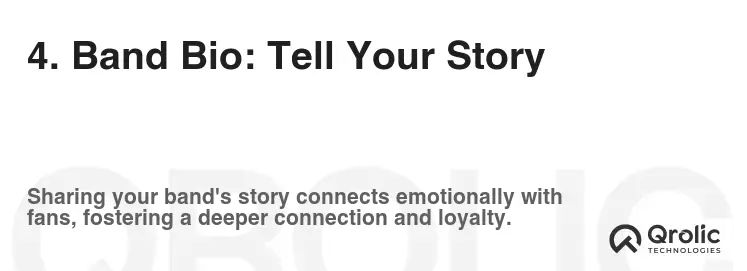
Your band bio is your opportunity to connect with fans on a personal level and share your unique story. It should be well-written, engaging, and informative.
4.1. Compelling Narrative: Hook Your Readers
- Why it matters: A compelling narrative can capture the reader’s attention and make them want to learn more about your band.
- What to include:
- Origins: Share the story of how your band formed.
- Influences: Discuss your musical influences.
- Achievements: Highlight your band’s achievements, such as awards, accolades, or notable performances.
- Unique Selling Proposition (USP): Explain what makes your band unique and different from other artists.
- Writing Style:
- Authentic Voice: Write in your band’s authentic voice.
- Engaging Language: Use vivid language and engaging storytelling techniques.
4.2. High-Quality Photos: Visual Support
- Why it matters: High-quality photos can enhance your band bio and make it more visually appealing.
- What to include:
- Band Photos: Include photos of the entire band.
- Individual Photos: Consider including individual photos of each band member.
- Action Shots: Add action shots from live performances.
- Image Optimization:
- High Resolution: Use high-resolution images.
- Web Optimization: Optimize images for web use.
4.3. Band Member Profiles: Introduce the Team
- Why it matters: Band member profiles allow fans to connect with each member of your band on a personal level.
- What to include:
- Name and Instrument: List each band member’s name and instrument.
- Background: Share a brief background about each band member’s musical journey.
- Influences: Discuss each band member’s musical influences.
- Personal Interests: Include some personal interests to help fans connect with them on a more personal level.
- Consistency:
- Consistent Format: Use a consistent format for all band member profiles.
- Up-to-Date Information: Keep the information up-to-date.
4.4. Contact Information: Make it Easy to Reach You
- Why it matters: Contact information allows fans, promoters, and media to easily reach your band.
- What to include:
- Email Address: Provide a dedicated email address for band inquiries.
- Phone Number (Optional): Consider providing a phone number for urgent inquiries.
- Social Media Links: Include links to all your social media profiles.
- Professionalism:
- Professional Email Address: Use a professional email address (e.g., bandname@gmail.com).
- Prompt Responses: Respond to inquiries promptly.
4.5. Press Kit: For Media and Industry Professionals
- Why it matters: A press kit provides media and industry professionals with all the information they need to promote your band.
- What to include:
- Band Bio: Include a detailed band bio.
- High-Resolution Photos: Provide high-resolution photos of the band.
- Music Samples: Include samples of your music.
- Press Releases: Add any press releases you’ve issued.
- Contact Information: Provide contact information for media inquiries.
- Accessibility:
- Easy Download: Make it easy to download the press kit as a single file (e.g., a ZIP file).
- Clear Labeling: Label the press kit clearly.
5. Merchandise Store: Sell Your Brand
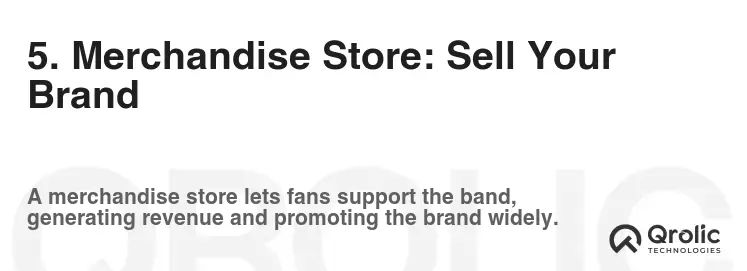
A merchandise store allows you to sell your band’s merchandise directly to fans, generating revenue and promoting your brand.
5.1. Easy-to-Navigate Storefront: A Seamless Shopping Experience
- Why it matters: A user-friendly storefront makes it easy for fans to browse and purchase your merchandise.
- What to include:
- Clear Categories: Organize your merchandise into clear categories (e.g., t-shirts, hoodies, posters, CDs).
- Search Functionality: Allow visitors to search for specific items.
- Product Filters: Provide product filters to narrow down search results.
- User Experience:
- Mobile Optimization: Ensure your storefront is optimized for mobile devices.
- Fast Loading Times: Optimize images and code to ensure fast loading times.
5.2. High-Quality Product Images: Showcase Your Merchandise
- Why it matters: High-quality product images showcase your merchandise in the best possible light and help fans make informed purchasing decisions.
- What to include:
- Multiple Angles: Provide multiple angles of each product.
- Zoom Functionality: Allow visitors to zoom in on product images.
- Lifestyle Images: Include lifestyle images that show your merchandise being used in real-life settings.
- Consistency:
- Consistent Lighting: Use consistent lighting for all product images.
- Professional Photography: Invest in professional product photography.
5.3. Secure Payment Processing: Build Trust
- Why it matters: Secure payment processing is essential for building trust with your customers and protecting their financial information.
- What to include:
- SSL Certificate: Install an SSL certificate to encrypt sensitive data.
- PCI Compliance: Ensure your payment processing system is PCI compliant.
- Trusted Payment Gateways: Use trusted payment gateways like PayPal or Stripe.
- Transparency:
- Clear Payment Policies: Clearly state your payment policies on your website.
- Privacy Policy: Provide a privacy policy that explains how you collect and use customer data.
5.4. Shipping and Handling Information: Set Expectations
- Why it matters: Providing clear shipping and handling information helps set expectations and prevent misunderstandings.
- What to include:
- Shipping Costs: Clearly state your shipping costs.
- Shipping Times: Provide estimated shipping times.
- Shipping Methods: List the available shipping methods.
- Return Policy: Clearly state your return policy.
- Customer Service:
- Prompt Responses: Respond to customer inquiries promptly.
- Easy Returns: Make it easy for customers to return items.
5.5. Inventory Management: Avoid Disappointments
- Why it matters: Accurate inventory management helps you avoid selling out of stock items and disappointing your customers.
- What to include:
- Real-Time Inventory Tracking: Use a system that tracks your inventory in real-time.
- Low Stock Alerts: Set up low stock alerts to notify you when items are running low.
- Out of Stock Notifications: Display out of stock notifications on your website.
- Efficiency:
- Automated Inventory Management: Use automated inventory management software to streamline your operations.
6. Qrolic Technologies: Your Partner in Website Excellence
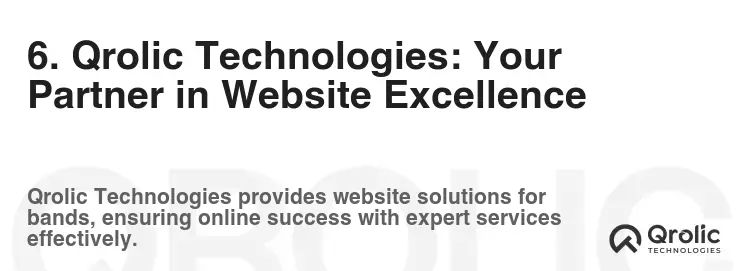
Qrolic Technologies (https://qrolic.com/) understands the unique needs of music bands and offers comprehensive website solutions to help you succeed online. From captivating designs to seamless functionality, Qrolic Technologies can create a website that perfectly reflects your band’s brand and helps you connect with fans around the world.
6.1. Custom Website Design: Tailored to Your Band’s Identity
Qrolic Technologies offers custom website design services to create a unique and visually stunning website that reflects your band’s personality and style. Their experienced designers will work closely with you to understand your vision and create a website that stands out from the crowd.
6.2. Responsive Design: Reach Fans on Any Device
Qrolic Technologies specializes in responsive website design, ensuring that your website looks and functions flawlessly on all devices, from desktops and laptops to tablets and smartphones. This is crucial for reaching fans on the go and providing a seamless user experience.
6.3. E-Commerce Solutions: Sell Your Music and Merchandise Online
Qrolic Technologies can help you set up a fully functional e-commerce store on your website, allowing you to sell your music, merchandise, and other products directly to fans. They offer secure payment processing, inventory management, and shipping integrations to streamline your online sales.
6.4. SEO Optimization: Get Discovered Online
Qrolic Technologies understands the importance of SEO for music bands. They offer comprehensive SEO services to help your website rank higher in search engine results, making it easier for fans to discover your music online.
6.5. Ongoing Support and Maintenance: Peace of Mind
Qrolic Technologies provides ongoing support and maintenance to ensure that your website is always up-to-date, secure, and functioning properly. Their team of experts is available to assist you with any technical issues or questions you may have.
7. Essential Back-End Features
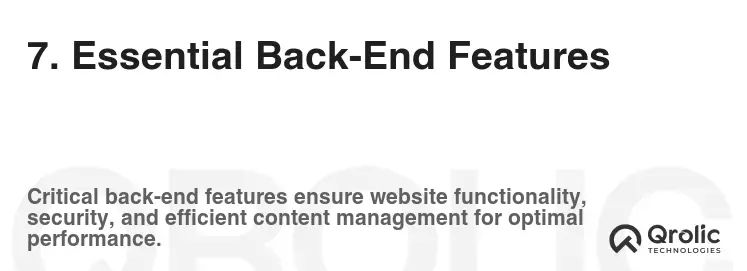
While the front-end features are what your fans see and interact with, the back-end features are crucial for managing and maintaining your website effectively.
7.1. Content Management System (CMS): Take Control
- Why it matters: A CMS allows you to easily update and manage your website’s content without needing to know how to code.
- Popular Options: WordPress, Drupal, and Joomla are popular CMS options.
- Key Features:
- Easy Content Editing: A user-friendly interface for creating and editing pages, posts, and other content.
- Media Library: A centralized location for storing and managing images, videos, and other media files.
- User Management: The ability to create and manage user accounts with different levels of access.
7.2. Analytics Tracking: Measure Your Success
- Why it matters: Analytics tracking allows you to monitor your website’s traffic, user behavior, and other key metrics. This information can help you optimize your website for better performance and engagement.
- Tools: Google Analytics is a popular and powerful analytics tool.
- Key Metrics:
- Traffic Sources: Where your website visitors are coming from (e.g., search engines, social media, referral links).
- Page Views: The number of times each page on your website is viewed.
- Bounce Rate: The percentage of visitors who leave your website after viewing only one page.
- Conversion Rate: The percentage of visitors who complete a desired action (e.g., signing up for your newsletter, purchasing merchandise).
7.3. Security Features: Protect Your Website
- Why it matters: Security features protect your website from hackers, malware, and other online threats.
- Essential Security Measures:
- SSL Certificate: As mentioned earlier, an SSL certificate encrypts sensitive data and protects your visitors’ information.
- Regular Backups: Regularly back up your website to protect against data loss.
- Strong Passwords: Use strong, unique passwords for all your website accounts.
- Security Plugins: Install security plugins to protect your website from common threats.
7.4. Database Management: Organize Your Data
- Why it matters: A database stores all your website’s data, including content, user information, and settings.
- Popular Database Systems: MySQL and PostgreSQL are popular database systems.
- Key Considerations:
- Database Optimization: Optimize your database for performance.
- Regular Maintenance: Perform regular database maintenance to ensure data integrity.
7.5. Email Marketing Integration: Communicate with Your Fans
- Why it matters: Email marketing is a powerful tool for communicating with your fans, promoting your music, and announcing upcoming shows.
- Email Marketing Platforms: Mailchimp, Constant Contact, and Sendinblue are popular email marketing platforms.
- Key Features:
- Email List Management: The ability to create and manage email lists.
- Email Template Design: Tools for creating visually appealing email templates.
- Email Automation: The ability to automate email marketing campaigns.
8. Beyond the Basics: Elevating Your Website
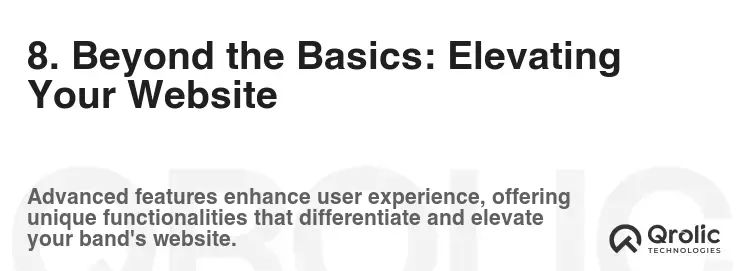
Once you have the essential features in place, consider adding these advanced features to further enhance your website and engage your fans.
8.1. Fan Forum: Build a Community
- Why it matters: A fan forum provides a platform for your fans to connect with each other, share their thoughts on your music, and discuss upcoming shows.
- Key Features:
- User Registration: Allow fans to create accounts and participate in the forum.
- Discussion Threads: Create discussion threads on various topics.
- Moderation Tools: Implement moderation tools to ensure a positive and respectful environment.
8.2. Live Streaming Integration: Connect in Real-Time
- Why it matters: Live streaming allows you to connect with your fans in real-time, whether you’re performing a concert, hosting a Q&A session, or simply chatting with your audience.
- Platforms: YouTube Live, Facebook Live, and Twitch are popular live streaming platforms.
- Integration: Embed your live streams directly into your website.
8.3. Interactive Elements: Engage Your Audience
- Why it matters: Interactive elements can make your website more engaging and encourage visitors to spend more time on your site.
- Examples:
- Polls and Quizzes: Create polls and quizzes related to your music or band history.
- Contests and Giveaways: Host contests and giveaways to reward your fans.
- Behind-the-Scenes Content: Share exclusive behind-the-scenes content, such as photos and videos from recording sessions or tour life.
8.4. Multilingual Support: Reach a Global Audience
- Why it matters: If you have fans around the world, consider adding multilingual support to your website.
- Implementation: Use a translation plugin or hire a professional translator.
8.5. Accessibility Features: Make Your Website Inclusive
- Why it matters: Accessibility features make your website usable for people with disabilities.
- Examples:
- Alt Text for Images: As mentioned earlier, use descriptive alt text for all images.
- Keyboard Navigation: Ensure your website can be navigated using a keyboard.
- Sufficient Color Contrast: Use sufficient color contrast to make text easy to read.
By implementing these must-have website features, your music band can create a powerful online presence that attracts new fans, engages existing fans, and ultimately helps you achieve your musical goals. Remember to prioritize user experience, optimize for search engines, and continuously update your website to keep it fresh and relevant. Good luck!







